Economics Assignment Help
The Effect of the 2008 Crisis on Germany’s Economy
Contents
Germany’s Response to the Economic Crisis of 2008. 2
Reasons for Germany’s Excellent Economic Performance after Economic Crisis. 5
Labor Market Reform in German after the Economic Crisis. 9
Introduction
The economic crisis of 2008 hit the global economy following the collapse of Lehman, an investment bank. The resulting bankruptcy triggered a disastrous aftershock that severely affected the GDP of many high-income economies. Germany is among the high-income countries that were affected by the economic crisis in terms of real GDP. For a long time, Germany has continued to record below-average economic performance (Obstfeld 39). Consequently, it was widely viewed as one of the several EU economies that would really struggle to survive the economic crisis. Incidentally, Germany defied its critics by achieving astounding success in the way it coped with the economic downturn (See Fig. 1).
The aim of this paper is to examine how Germany succeeded in recovering the losses sustained during the economic recession of 2008 and 2009. It particularly focuses on the process of strong economic recovery that followed the economic crisis and the factors that triggered it. This discussion is presented in the context of an expected slow-down in the economic recovery process, partly because of the eurozone sovereign debt crisis and tensions in the EU financial markets.
Germany’s Response to the Economic Crisis of 2008
A number of factors gave Germany a competitive edge in its efforts to mitigate the negative effects of the economic recession. For instance, the country’s production focuses on manufacturing goods more than in other highly industrialized nations. This situation made Germany’s economy to rely more on emerging economies than in industrial economies. Emerging economies rely a lot on imports in the form of manufactured goods. As more of these emerging economies became destination countries of goods exported by Germany, the country became less reliant on crisis-stricken high-income Western economies.
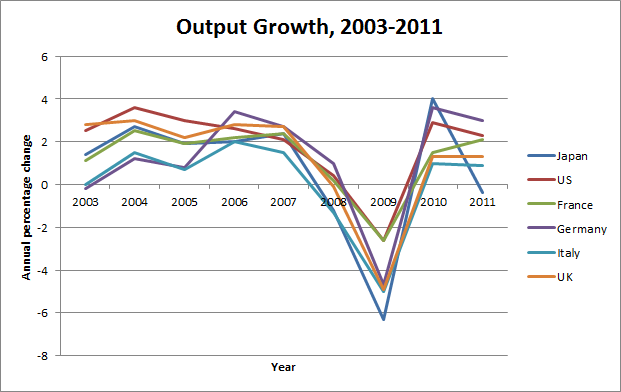
Fig. 1: A nine-year (2003-2011) GDP growth comparison for six high-income economies: Japan, US, France, Germany, Italy, and UK (Source: UNCTAD secretariat calculations, based on United Nations, Department of Economic and Social Affairs – UN/DESA).
When European standards were harmonized under the EU to remove non-trade barriers, European producers found out that they could easily enter the German market. This transformed the country’s competitive environment. It compelled German companies to stop modeling their production majorly on the domestic market. Rather, they began producing standard products to be marketed in Germany as well as across Europe and the rest of the world. Even before this transformation, German had become the world’s leader in the export of manufactured goods. This strategic shift only increased its overall competitiveness while at the same time helping it maintain its leadership position until 2009. In 2009, Germany was overtaken by China largely because of the economic recession. Despite this slow-down in growth in the manufacturing sector, the strategic shift greatly enabled Germany to cope with the recession; it helped the country to avoid over-relying on exports to high-income Western countries, which were the hardest-hit by the economic recession.
The economic crisis hit the world at a time when foreign trade was exerting increased weight on Germany. This situation coincided with the onset of the newest wave of globalization, which greatly reduced the volume of trade between the country and its partners in the euro area. For instance, German exports to the euro area decreased by 10 percent between 1991 and 2006 (Rinne and Zimmermann 12). This decrease occurred at a time when the single European market had been created and exchange rate risk in the monetary union had been eliminated. These conditions favored higher intra-area trading and greater integration. This indicates that Germany’s manufacturing sector has for the last two decades focused primarily on new world economic areas. This approach has turned out to be advantageous because it has formed the foundation of the ongoing process of economic recovery in this post-crisis era.
During the economic boom that preceded the economic crisis, Germany’s economy used its productive capacities well above is the average consumption level (Crimmann, Wießner and Bellmann 19). This trend was particularly between early 2005 and late 2008. It also emerged again in 2011. This is a strong indication of the strong economic upswing that helped to cushion Germany against the negative effects of the crisis. It cushioned the economy mainly because of an overall increase in employment (See Fig. 2), working hours, and overall hourly productivity. Consequently, Germany is among the few EU countries that have reported decreasing budget deficits (Vroman and Vera 112). This condition is attributed partly to the buoyant state of the country’s labor market as well as the favorability of its current financing terms.
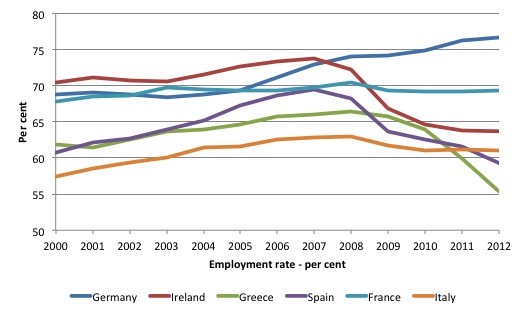
Fig. 2. A line graph showing Germany’s employment rate in comparison to that of other EU economies: Ireland, Greece, Spain, Italy, and France between 2000 and 2012).
In 2010, total employment in Germany hit record levels since the onset of the crisis. Moreover, in 2012, the Federal Ministry of Economics and Technology projected that the number of persons in employment was the highest since reunification. A rising trend was also observed in 2011 in regards to the number of jobs that were subject to social security contributions, which totaled 28.4 million (Bastasin 36). This rising trend-led reputable institutions such as the German Council of Economic Experts, OECD (Organization for Economic Cooperation and Development), and the IMF (International Monetary Fund) to indicate that by 2011, Germany was doing better economically than even before the onset of the crisis.
A major indicator of this economic performance was the constant rise in the level of employment. In 2005, Germany’s unemployment rate of 11 percent was the sixth highest in the OECD; by 2011, this rate was among the lowest in the OECD, having almost halved in the post-crisis era (Alouia, Aïssaa and Nguyen 136). The labor market developments unfolding in Germany were surprising because they occurred in spite of a fall in the country’s GDP as well as a myriad of external challenges. Apart from the active policy measures of stabilization through bailouts and economic stimulus packages, Germany benefited a lot its domestic fundamentals. The country entered the economic crisis at a time when its labor markets had been made flexible, the housing boom was absent, and corporate balance sheets were solid. These strengths enabled the economy to make up for its initial lack of a fiscal consolidation strategy.
Reasons for Germany’s Excellent Economic Performance after Economic Crisis
A major reason why Germany did well economically after the crisis was its adoption of the initially-controversial policy measures aimed at economic stabilization. The German government was initially hesitant to adopt these measures. Upon accepting responsibility for deficits arising from the crisis, the German parliament approved the establishment of economic stimulus packages worth €82 billion (Cesaratto and Stirati 71). The packages were targeted at infrastructure projects and a host of other new investments. Despite initial resistance, the rationale for the stimulus packages gained widespread acceptability across the country. The measures prevented the country’s financial system from collapsing while laying the foundation for future-oriented investments.
Opposition against stimulus packages as a form of a demand-management approach was at first rife in Germany following the onset of the crisis. The core of the argument for opponents was that such measures were unlikely to stabilize private and public demand as well as revitalize employment. In a few instances, the measures were viewed as rather appropriate in light of the extremity of the economic crisis in 2009 and the negative prospects for the promising German economy. Germany had one of the largest stimulus programs in the EU. In the end, the decision by the country to invest heavily in stimulus packages was vindicated by the country’s effectiveness in overcoming the negative effects of the crisis. For instance, in late 2009, Germany had one of the lowest public debts in the EU (see Fig. 3 below).
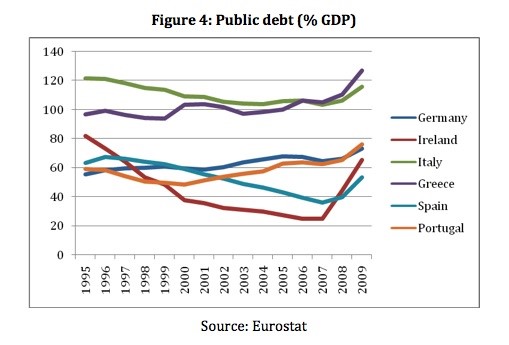
Fig. 3: Public debt (as a percentage of GDP) of six EU countries: Germany, Ireland, Italy, Greece, Spain, and Portugal) (Source: Eurostat).
The success did not arise from stimulus packages alone; it was also contributed to by the efforts of the private sector, especially employers’ associations and trade unions. These entities contributed to labor market reforms that led to the emergence of a wage policy that exploited the German strengths in the realm of economic collaboration with stakeholders in the delivery of social welfare to boost employment even in a post-crisis era. For instance, the new wage policy operated in such a way that employers were exposed to disincentives for worker lay-offs during the downturn.
The stability of the German labor market during the recovery process was occasioned by several factors. One of them was the presence of fiscal policy measures. Skills hoarding has been a common practice, facilitated by a large pool of labor force. Short-time work has also been relied upon particularly in the expansive export-directed manufacturing sector. Although these practices were being used in West Germany as early as in the 1970s, their wide use since 2010 surpassed any previous efforts. Incidentally, they turned out to be productive because they were based on an accurate projection of the economic crisis being a short-term phenomenon.
German companies also made a correct prediction of the changes in the structure of products that they needed to introduce to meet future demand in the country, across Europe, and in the global market. This turned out to be a major factor that influenced the country’s ability to recover from the economic crisis. Before the onset of the crisis, many German companies had reported increased profitability. After the crisis, changes in the structure of products and the country’s labor market took the place of downsizing, leading to a decrease in the level of uncertainty and a corresponding increase in entrepreneurial success.
As part of crisis management in post-crisis Germany, labor market reforms led to external flexibility while firm-specific reforms led to internal flexibility. This approach made Germany’s labor market highly resilient despite the fact that the country was heavily affected by the economic crisis through a sharp decline in German exports. The recovery was remarkable considering that Germany relies heavily on an export model that is heavily anchored on automobile and machinery manufacturing. The recovery efforts were helped a lot by the impressive performance before the crisis as well as the wage moderation efforts that were made after the crisis. These efforts led to increased flexibility despite real GDP fluctuations (See fig. 4 below).
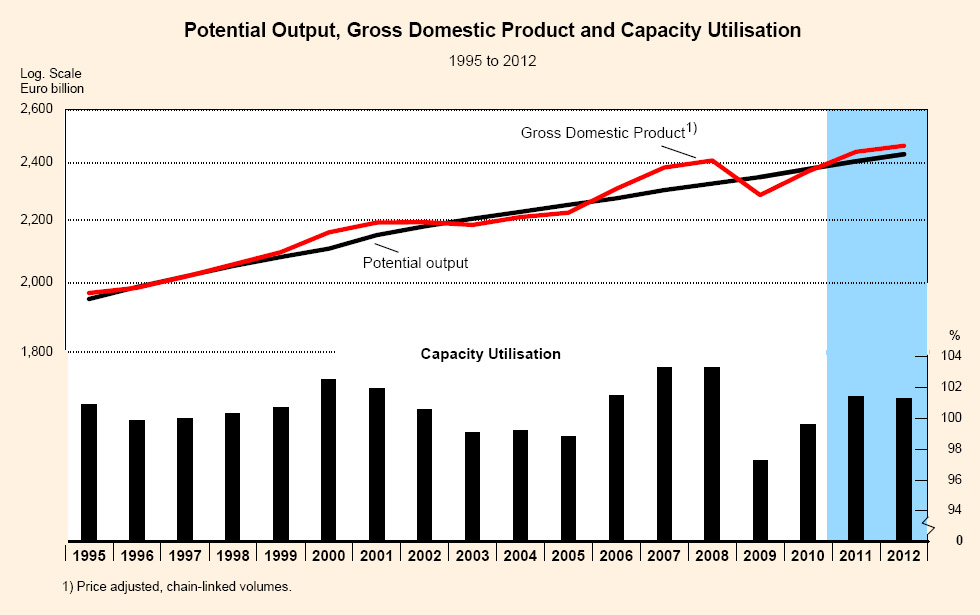
Fig. 4: Real GDP fluctuations potential output, and capacity utilization in Germany between 1995 and 2012 (Source: German Council of Economic Experts 2011a, p. 12.)
Labor Market Reform in German after the Economic Crisis
One of the most hard-hit sectors during the economic crisis was the labor market. The German labor market was also affected by the crisis. Different countries adapted to this phenomenon in different ways. Germany’s response was rather unique, hence the use of the term “labor market miracle” in reference to its astounding success (Möller 325). After the crisis, a consistent decrease in registered unemployment was reported (Rinne and Zimmermann 12). Moreover, in annual average, the number of people in employment increased at a time when Germany had experienced in 2009 the largest real GDP fall since the end of World War II (Rinne and Zimmermann 12).
Germany went to great lengths to hoard skilled employees with a view to ensure their availability once the economic upswing returned. During the economic crisis, there was a considerable decrease in the number of working hours as well as overtime hours available per employee. This trend emerged in 2009 at the height of the crisis. During the same time, the number of temporary agency workers being demanded by companies decreased significantly. Instead, there was an increase in workers participating in short-time employment. According to Arranz, Serrano, and Hernanz, demand for short-time work increased more than tenfold between early 2008 and late 2009 (337).
These labor market adjustments go a long way in explaining why Germany avoided a slump in the level of employment as well as a rise in unit labor cost (See Fig. 5). It also explains why there was a drop in productivity per hour at a time when companies were willing to accept strong unit labor costs. These conditions created the ideal environment for a speedy recovery and resumption of economic growth in 2010 and afterward. The adjustments in the labor market created a condition of underutilized capacities. These capacities could be utilized optimally and profitably in the country’s production process once the country went back on the path of recovery. As long as the soundness of the supply side of the German economy was maintained, the recovery process would be speedy; ultimately, this proved to be the case.
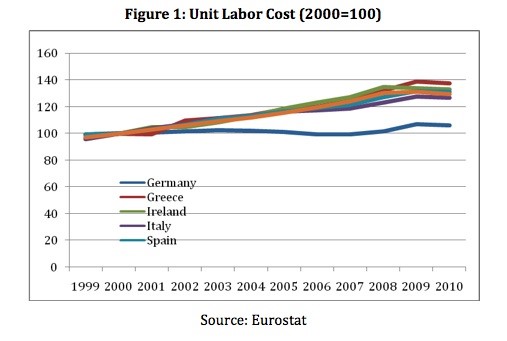
Fig. 5: Unit labor cost between 1999 and 2010 in four EU economies: Germany, Greece, Ireland, Italy, and Spain).
German enterprises avoided dismissing employees with skills whenever possible because of the awareness that these employees would contribute to growth once upswing returned. This decision was founded on the assumption that the crisis was a short-term phenomenon. The labor-market strategies that the German manufacturing sector adopted also projected it as the backbone of the country’s economy. This is by no means an overestimation of the importance of this sector considering that it contributed to 29.6 percent of all industrial production in the EU.
Conclusion
This paper has provided an in-depth analysis of the impact of the economic crisis of 2008 on the German economy. An important finding is that Germany was widely expected to struggle during and after the economic crisis because of its below-average economic performance, at least by the standards of high-income economies. Surprisingly, the country was among the few that achieved the highest levels of post-crisis recovery in which has been dubbed the “German labor market miracle”.
The country’s manufacturing sector was at the heart of this success because this is where most of the country’s labor market adjustment policies were targeted. Moreover, the sector focused on new world economic areas. This enabled the country to avoid the hazardous contagion effect of high-income economies such as the United States, which were the epicenter of the crisis. Moreover, Germany’s economy used its productive capacities well above is the average consumption level. This led to increased employment, better post-crisis economic outlook, and favorable financing terms.
The German economy performed excellently after the economic crisis because active policy measures of stabilization such as economic stimulus packages were introduced, domestic fundamentals were strong, labor markets were flexible, no housing boom existed, and corporate balance sheets were solid. Two crucial labor market adjustments were introduced: hoarding of skilled employees and the use of short-time work. These strategies demonstrated the importance of the German manufacturing sector not just nationally but also in the EU context. It also established the foundation for economic recovery in the years following the economic crisis.
Works Cited
Alouia, Riadh., Aïssaa, Mohamed. and Nguyen, Duc. “Global financial crisis, extreme interdependences, and contagion effects: The role of economic structure?” Journal of Banking & Finance, 35.1 (2011): 130–141.
Arranz, José., Serrano, Carlos. and Hernanz, Virginia. “Active labor market policies in Spain: A macroeconomic evaluation.” International Labor Review, 152.2 (2013): 327–348.
Bastasin, Carlo. Germany: A Global Miracle and a European Challenge. Global Economy & Development, Working Paper 62, May 2013.
Cesaratto, Sergio. and Stirati, Antonella. “Germany and the European and Global Crises.” International Journal of Political Economy, 39.4 (2010): 56-86.
Crimmann, Andreas., Wießner, Frank. and Bellmann, Lutz. The German work-sharing scheme: An instrument for the crisis. Geneva: International Labor Organization, 2010. Print.
Möller, Joachim. “The German labor market response in the world recession – de-mystifying a miracle.” Zeitschrift für ArbeitsmarktForschung, 42.4 (2010): 325-336.
Obstfeld, Maurice. and Rogoff, Kenneth. Global Imbalances and the Financial Crisis: Products of Common Causes. Berkeley: University of California Press, 2009. Print.
Rinne, Ulf. and Zimmermann, Klaus. “Another economic miracle? The German labor market and the Great Recession.” IZA Journal of Labor Policy, 1.3 (2012): 1-21.
Vroman, Wayne. and Vera, Brusentsev. Short-Time Compensation as a Policy to Stabilize Employment. Newark: University of Delaware Press, 2009. Print.
Top-quality papers guaranteed
100% original papers
We sell only unique pieces of writing completed according to your demands.
Confidential service
We use security encryption to keep your personal data protected.
Money-back guarantee
We can give your money back if something goes wrong with your order.
Enjoy the free features we offer to everyone
-
Title page
Get a free title page formatted according to the specifics of your particular style.
-
Custom formatting
Request us to use APA, MLA, Harvard, Chicago, or any other style for your essay.
-
Bibliography page
Don’t pay extra for a list of references that perfectly fits your academic needs.
-
24/7 support assistance
Ask us a question anytime you need to—we don’t charge extra for supporting you!

Calculate how much your essay costs
What we are popular for
- English 101
- History
- Business Studies
- Management
- Literature
- Composition
- Psychology
- Philosophy
- Marketing
- Economics



